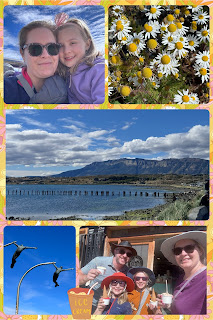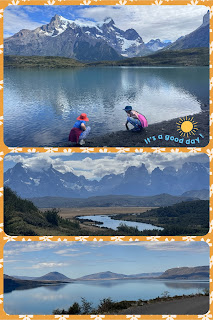We took the bus from Punto Arenas to Puerto Natales. Over the 3 hour journey, it was amazing to see how the scenery changed from a very flat and treeless environment to a more mountainous scenery with more vegetation and trees. Along the way we drove along the Argentinian border, and at some places could see far into Argentina. From what we could gather this part of Chile can only be accessible either by air, sea or through Argentina.
Puerto Natales is a quiet little town, without any high rise buildings. You can walk it very easily within just a couple of hours! And we covered most of the sights within an hour or so. It’s definitely a place where time slows down and you need to adjust your pace to suit the locals. There is definitely no rush here…
Whilst in Puerto Natales, we also got to try some Guanaca. The Guanaca (Lama guanicoe) is a native animal to South America, and is closely related to the llama. We were told that it is the wild version of their llamas (like wild boars are to domesticated pigs). The grilled version we had was very gamey and a touch tough, but we suspect that is due to it being a very lean piece of meat and how it was prepared.
The main reason for coming to Puerto Natales is to go to Torres Del Paine national park. It is an amazing nature reserve that is centred on a number of very tall mountains (highest being 2600m above sea level), the famous Grey Glacier, and lots of glacier lakes. It take a few hours just to drive around, through the rolling hills round the lakes. While the gravel roads are bumpy and the tarred road sections are full of pot holes, it was definitely worth it as the scenery was amazing!
We did two main activities whilst at the park. The first was going on a catamaran boat trip to see the Grey Glacier up close. The Grey Glacier is melting into Lago Grey, and we were on the Grey III (really creative naming…). As we sailed towards the glacier we saw some waterfalls and icebergs in the lake. That of course lead to a conversation about what happened to Grey I and Grey II boats… We got very close to the glacier, a stone’s throw away, and the range of white to blue colours were spectacular. The boat crew even fished out a small chuck of the glacier and passed it around the passengers, so we can all say we have touched a glacier.
What is sad is the glacier itself is getting smaller each year, and its retreat has accelerated over the past 30 years. We got to see pictures of it from 1945 and were amazed how much it has lost. Most likely that the glacier will be gone within our girls lifetime.
As we were in a nature park, we had to go for a hike, and there is a huge selection. Unfortunately most of the hikes are multi-day hikes, with the bigger ones being 5/6 days long, taking you round the central set of mountains. Needless to say we did not embark on such a hike, instead we focused on shorter ones that we could manage in a day. We did a little one around our base camp and a nicer longer one at the Salto Grande (Grand waterfall), with a hike to the lake view point. The girls were amazing, walking together in front of us, chatting away the whole way. What was amazing about this walk was that along the way we would suddenly hear a massive CRACK, groan thunder type noise... It took a while to convince the girls that the sound came from the glaciers and were not earth quakes. They are known as Ice Quakes and occur when crevasses form (ice slits).
Whilst in Torres Del Paine (or as Maxine called it “Tourists are a Pain”, as there were PLENTY of tourists there!) we got to camp at one of the “refuges” that are used by hikers. It was actually quite fancy with a tent on stilts, where you had to climb a ladder to get in. The girls LOVED IT, of course!
Torres Del Paine ends our time in the southern part of Chile. Now we head back to towards Santiago.
P.S. In a previous log we mentioned about the bread being different. We learnt that the local flour actually has low levels of gluten, and that is the reason why the bread comes out harder and drier than we are accustomed to.

















Comments
Post a Comment